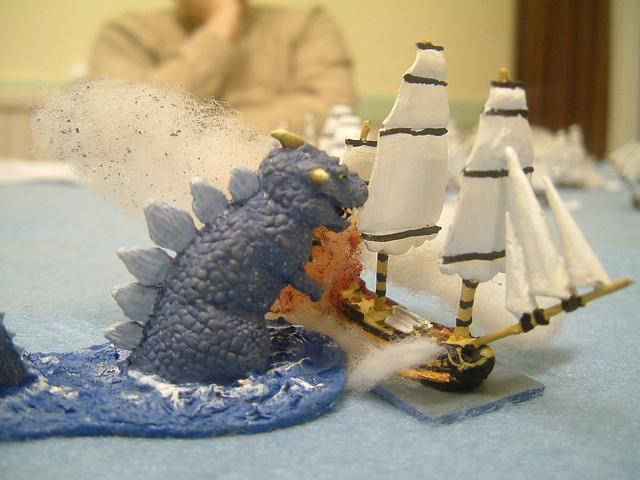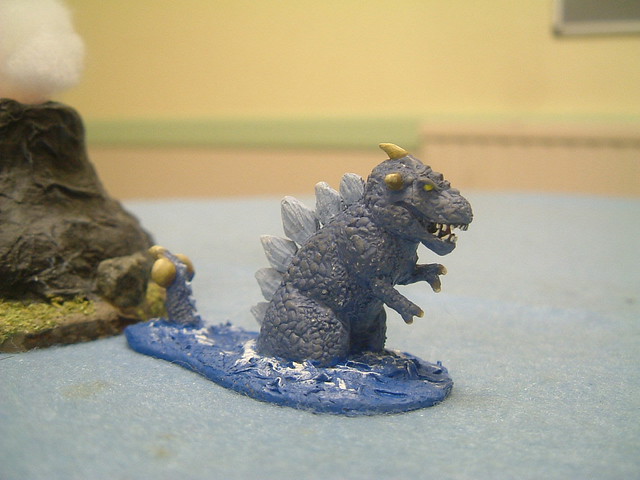Kaiju are giant Japanese monsters. And it is a little-known fact that navies of the age of sail were in constant danger from them. Those that were around in late 18th and early 19th century were not, perhaps, as large as their counterparts from the Atomic Era, but were still a formidable opponent.
This article looks at incorporating Kaiju into 'Form Line of Battle', as this happens to be my favourite set of rules for this period. You can purchase them from A&A Game Engineering. They offer quick games, limited book-keeping and an unusual sailing system based around random movement distances. It was inspired by the waterline not-Godzilla figure, Torgon, made by Khurasan Miniatures.
For the purposes of these rules the Kaiju is assumed to be a bipedal, semi-aquatic dinosaur-like creature, 2-300 feet in height and capable of breathing fire. Adjust the rules accordingly for variations on this theme.
This article looks at incorporating Kaiju into 'Form Line of Battle', as this happens to be my favourite set of rules for this period. You can purchase them from A&A Game Engineering. They offer quick games, limited book-keeping and an unusual sailing system based around random movement distances. It was inspired by the waterline not-Godzilla figure, Torgon, made by Khurasan Miniatures.
For the purposes of these rules the Kaiju is assumed to be a bipedal, semi-aquatic dinosaur-like creature, 2-300 feet in height and capable of breathing fire. Adjust the rules accordingly for variations on this theme.
A Kaiju is controlled by the game system
rather than a player. This makes it an ideal opponent for a particularly
masochistic solo gamer.
A Kaiju has its own set of three cards in
the deck. As with ships the first is for Command and Repair and the other two
allow it to move and attack.
Each Kaiju starts with three tokens
representing its flame-breath. It can never have more than three of these flame
tokens at any one time. In its Command and Repair phase it automatically gains
one flame token if it currently has less than three. It also gains additional
tokens by eating ships; Kaiju of this period could metabolise gunpowder. Well-known fact.
A Kaiju has 10 hull factors. When they are
all lost it sinks beneath the waves, maybe dead, maybe not. Who can tell?
A Kaiju moves 3D6 regardless of wind
direction. If there are ships within an arc 180 degrees to its front then it
will turn to face the nearest and move directly towards it. If no such ship is
present it will expend the highest movement dice roll and turn until it is
facing a ship, then move towards it with the remainder of the roll. If it
contacts a ship it will stop moving whilst it attempts to eat it.
A Kaiju not in contact with a ship will
attempt to engage the nearest ship in its frontal arc with its flame-breath. It
must, however, have sufficient charge available to do this.
Flame-breath has a maximum range of 30cm:
Up to 10cm is Point Blank range.
Up to 20cm is Short range
Up to 30cm is Long range.
The number of fire tokens needed to make
the attack depends on the range.
Range
|
Tokens
|
Point-Blank
|
1
|
Short
|
2
|
Long
|
3
|
Two rolls are made. First roll a D6 to see
if the attack hits:
Range
|
Hit Roll
|
Point-Blank
|
1+
|
Short
|
3+
|
Long
|
5+
|
If the target is a 4th or 5th
rate deduct one from the roll.
If the target is 6th rate or
smaller deduct two from the roll.
An unmodified roll of ‘6’ always hits.
If the attack hits roll a red D6 and a
white D6. The red D6 determines how many ‘r’ hits are scored. Adjust the roll
for the range:
Range
|
Hit Roll
|
Point-Blank
|
0
|
Short
|
-1
|
Long
|
-2
|
Modified rolls of less than zero are
treated as zero.
Apply the damage to the target ship
normally. In addition one fire is automatically started on the target. If the
white D6 scores ‘6’ a critical hit should be rolled (which may start another
fire, of course).
If a Kaiju is in contact with a ship it
will attempt to crush and eat it rather than use its fire-breath. Roll 1D6 and
add one to the roll – this is the number of ‘r’ hits scored on the vessel. In
addition a critical hit is automatically scored. The ship is considered
grappled and unable to move until the Kaiju is forced to retreat or the ship is
eaten. It may fire, however.
A ship in contact with a Kaiju that has no
broadside factors remaining, is struck or is sinking is automatically eaten.
Eating a ship takes a full Movement or
Command and Repair phase, during which the Kaiju remains in place. The ship
model is removed, and the Kaiju gains fire tokens based on the size of its
meal:
Ship Size
|
Tokens Gained
|
1st or 2nd Rate
|
3
|
3rd or 4th Rate
|
2
|
Other
|
1
|
Attacking The Kaiju
Resolve firing on a Kaiju exactly as if it
were a ship. However only damage to hull factors and critical hits have any
relevance; other damage effects are ignored. Thus a hit that scores ‘r’ will
have no effect, unless a double was rolled in which case a critical hit is
scored. A hit that scored ‘2r’ will score one point of ‘hull’ damage. And so on.
A ship which is in contact with a Kaiju
gets a +1 to its broadside roll for each remaining crew factor. This represents
the effect of marines firing at the Kaju and is, quite frankly, a bonus any
ship in the grip of a Kaiju desperately needs.
A Kaiju which has taken at least half of
its Hull hits loses 1D6 from its movement.
A Kaiju has a special critical hit table.
Roll 1D6:
Roll
|
Effect
|
1
|
+2
‘Hull’
|
2
|
+1
‘Hull’
|
3
|
Submerge
|
4
|
Submerge
|
5
|
Retreat
|
6
|
Retreat
|
Submerge – The Kaiju lets go of any ship it
is trying to eat and is removed from the table, its position being marked. In
each subsequent Kaiju Movement phase roll a D6 – on a 5+ the Kaiju reappears.
Roll 1D6 for each Movement phase it has remained submerged (including the
current one); it appears that many cm away from the point at which it
originally went under the water in a randomly determined direction. It may not
move or attack in the phase it reappears. A submerged Kaiju does regenerate
fire tokens during its Command and Repair phase.
Retreat – The Kaiju immediately releases
any ship it is trying to eat and is moved 1D6cm away from the firing vessel. A
Kaiju can retreat any number of times.
The rules above should work with multiple
Kaiju. Give each one its own set of cards and flame tokens, and treat them as a
1st Rate for target purposes.
To see pictures of an actual game CLICK HERE.



Excellent - love it :)
ReplyDeleteThanks. It's a testament to the simplicity of FLOB that these rules virtually wrote themselves :)
DeleteGreat idea!
ReplyDeleteSir your mad! But as I just picked up Samuria Robot Battle Royale, you might not be the only one?
ReplyDelete